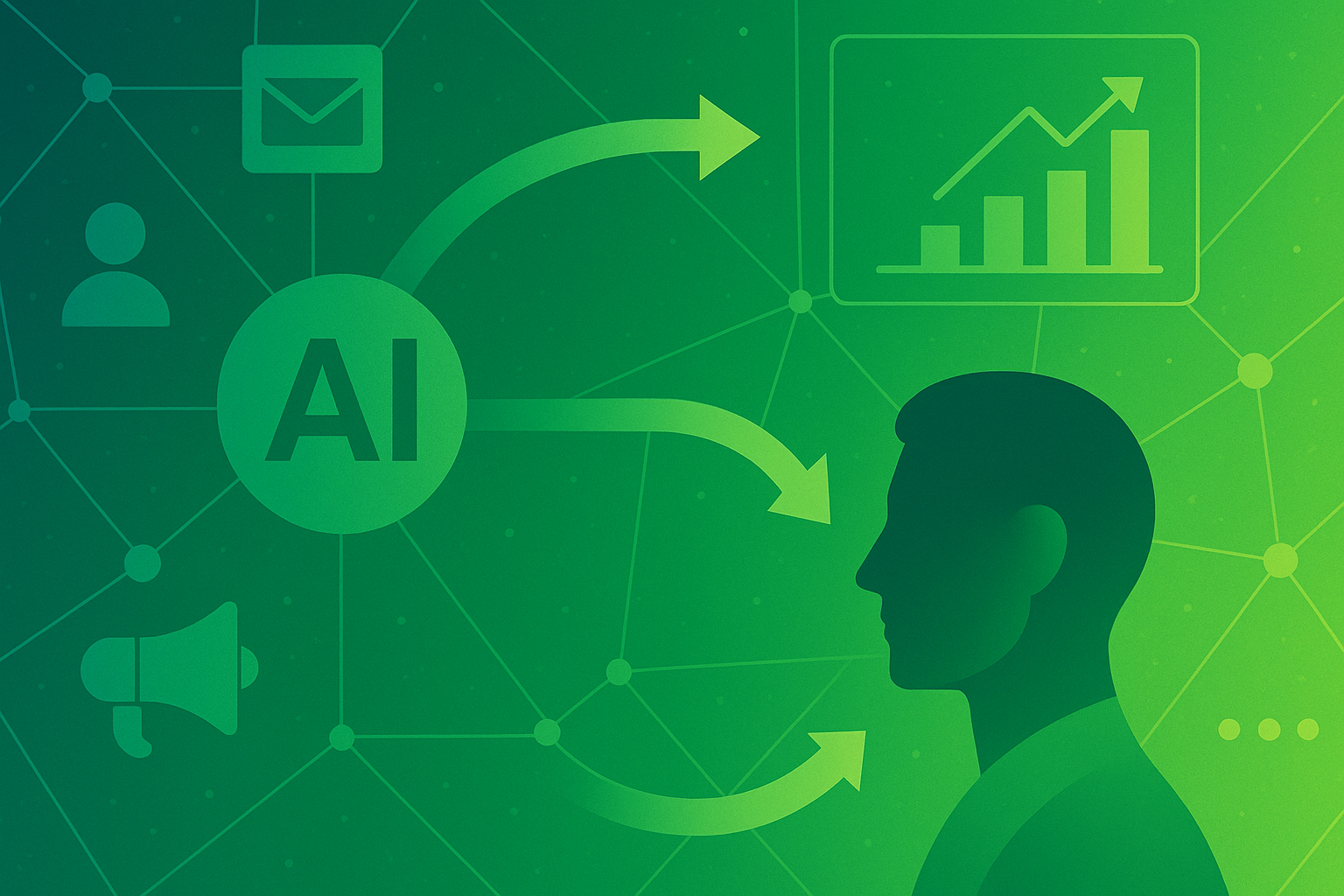“Describe what you want to achieve, AI handles how to do it.”
This is the principle of vibe coding introduced by OpenAI’s Andrej Karpathy, now revolutionizing not just software development but the entire approach to digital marketing.
Vibe marketing emerges as the natural evolution: instead of manually creating every piece of content, marketers describe the objective and desired “vibe,” letting AI handle execution across hundreds of variants and channels.
But while everyone talks about AI for content generation, the real revolution lies in rethinking the entire marketing workflow.
As highlighted in this article of vincos.it, vibe marketing isn’t simply “using ChatGPT to write posts.” It’s a paradigm shift where the marketer becomes the conductor of AI systems that autonomously manage creation, testing, distribution, and optimization (ndr we already talked about the importance of the agent orchesrtation skill here).
So a team of 3 can now outperform marketing departments of 20+ people—not because they work harder, but because they work fundamentally differently.
From manual execution to strategic orchestration
Vibe marketing operates on a counterintuitive principle: less direct control, more strategic impact.
Instead of crafting every detail of a campaign, marketers define high-level parameters—tone, objectives, brand constraints—and let orchestrated AI systems handle implementation.
The traditional marketing workflow is linear and manual: write copy, create visuals, set up campaigns, wait for results, optimize. Each step requires hands-on execution. Vibe marketing transforms this into parallel, AI-driven processes where multiple agents work simultaneously on different aspects of the campaign.
You focus on the thinking, AI agents handle the doing.
You’re no longer writing copy—you’re teaching a system your brand’s voice.
You’re not designing visuals—you’re defining your aesthetic principles.
You’re not manually testing variants—you’re setting success criteria and letting the system find optimal combinations.
This isn’t about replacing human creativity. It’s about amplifying it. When you remove execution bottlenecks, you can spend more time on what actually matters: understanding your market, crafting compelling narratives, and building authentic connections with your audience.
The “vibe” you define becomes the North Star that guides thousands of micro-decisions made by your AI agents.
As Karpathy described in his original February 2025 post, this approach means “you fully give in to the vibes, embrace exponentials, and forget that the code even exists.” Applied to marketing, you focus on strategic direction while AI handles the exponential scaling of execution.

Why context engineering beats raw AI every time
The key insight about AI systems is simple but profound: “Raw LLMs hallucinate without grounding.” A generic LLM produces generic content. The transformation happens when you build a comprehensive context system around the AI.
Think of it this way: giving ChatGPT a one-line prompt is like hiring someone who knows nothing about your company and expecting brilliant, on-brand content. It doesn’t work. But when you build a system that includes:
- Your brand’s complete history and evolution
- Verified tone of voice from high-performing content
- Deep product knowledge translated into customer benefits
- Real-time industry intelligence
- Continuous feedback loops from campaign performance
Suddenly, the AI produces content that feels authentically yours. This is the difference between using AI tools and building a vibe marketing system.
The principle is similar to how some platforms can create sophisticated outputs where others using similar AI technology produce generic templates. The magic isn’t in having exclusive access to AI—it’s in the context engineering, retrieval-augmented generation, and validation guardrails that transform raw AI capabilities into professional output.
To be clear: the quality of your base model still matters. Even the best context system won’t turn a mediocre model into GPT-4. But without proper context engineering, even the most advanced models will produce generic, off-brand content. Your competitive advantage comes from the system you build around the AI, not just the AI you choose.
Real scenarios: Beyond theory
Scenario 1: B2B SaaS scale-up
A SaaS company with a 4-person marketing team implements vibe marketing for content production. After 6 months:
- Content output increases from 8 to 40 articles monthly
- Production time per article drops from 8 hours to 90 minutes
- Organic traffic grows by 220%
- The key? They didn’t write faster. They built a system that deeply understands their product, market, and voice
Scenario 2: D2C beauty brand
Natural cosmetics brand uses vibe marketing for social media:
- System monitors beauty trends in real-time
- Generates content that catches micro-trends while relevant
- Advertising ROI improves by 180% in 4 months
- External agency costs reduced by 75%
Scenario 3: Marketing agency transformation
Small agency (12 people) competes with larger players through vibe marketing:
- Manages 3x more clients with the same team
- Client onboarding time: from 3 weeks to 3 days
- Client retention increases by 40%
- How? A system that rapidly learns each client’s “DNA” and maintains consistency across all deliverables
The risks no one talks about (and how to avoid them)
Vibe marketing isn’t a magic solution. The main failure patterns include:
1. The “set and forget” illusion
Companies believe they can configure the system once and forget about it. Result: after 2-3 months, content becomes stale and repetitive. Solution: Vibe marketing requires continuous curation—not less work, but different work.
2. The scaled mediocrity paradox
Producing 100x more content… all equally mediocre. This happens when you scale quantity without investing in context system quality. Solution: Build depth first (rich knowledge base), then scale breadth.
3. The vanity metrics trap
“We produce 10x more content!” means nothing if it doesn’t generate business results. Solution: Define outcome KPIs (qualified leads, pipeline influenced) not output metrics.
4. Brand uncanny valley
When content is “almost” on-brand but not quite, creating an unsettling feeling in loyal customers. Solution: Involve your best performers in the system training phase.

How to implement vibe marketing in your organization
Phase 1: Audit and preparation (2-4 weeks)
- Map all current content creation processes
- Identify recurring bottlenecks
- Document brand voice, success examples, guidelines in a structured way
- Define clear success metrics (not “more content” but “more results”)
Phase 2: Building your “brand brain” (4-6 weeks)
- Create structured knowledge base with:
- Best performing content from the last 12 months
- Real customer feedback and language
- Competitive intelligence
- Technical product documentation “translated” into benefits
- Implement feedback loops for continuous learning
Phase 3: Controlled pilot (4 weeks)
- Choose ONE channel or content type to start
- Run parallel: human team vs AI system
- Measure not just performance but time invested
- Iterate daily based on feedback
Phase 4: Intelligent scaling (ongoing)
- Gradually expand to other channels/formats
- Always maintain a “human in the loop” for quality control
- Invest 20% of time improving the system, 80% executing
The future is here (but not evenly distributed)
William Gibson was right: the future is already here, it’s just not evenly distributed. While most companies still use ChatGPT as a “writing assistant,” vibe marketing pioneers are building true “virtual teams” that:
- Continuously learn from market feedback
- Coordinate with each other like a human team would
- Maintain brand consistency at a scale impossible for humans
- Free marketers to focus on high-level strategy and creativity
The question isn’t whether to adopt vibe marketing, but how quickly you can afford NOT to adopt it while your competitors do.
Building your brand brain: The next evolution
The market is responding to this shift with various solutions. Some focus on prompt engineering, others on workflow automation. But the most sophisticated approaches recognize that vibe marketing requires more than isolated tools—it needs a system that deeply understands your brand’s DNA and applies it consistently at scale.
At Fylle, we’re developing exactly this: a system that creates an intelligent brand brain through guided onboarding, maintained by assistant agents that keep it perpetually current. When your AI agents have access to this living knowledge base, they don’t just generate content—they create authentic brand expressions that feel genuinely yours, every time.
Ready to explore vibe marketing for your brand?
The technology exists. The methodology is proven. The only question is whether you’ll lead this transformation or follow it.
This article was produced by Fylle’s AI content marketing system.
All images were created using OpenAI’s image generation technology.




